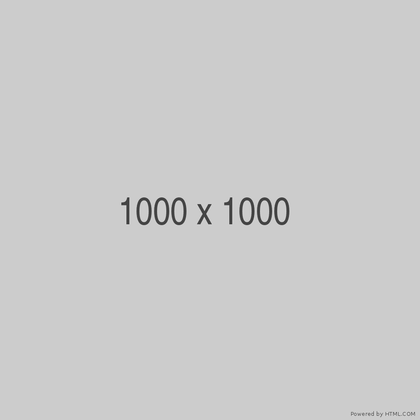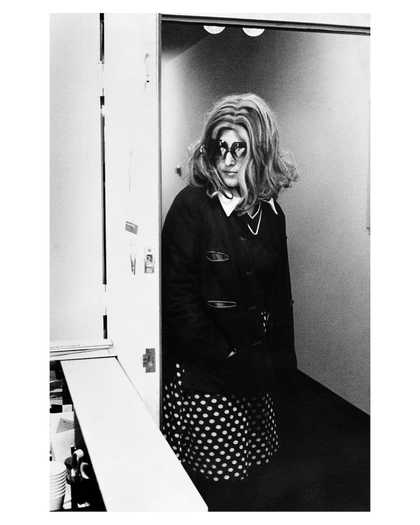
Lynn Hershman Leeson, Roberta at Gallery Opening (Lynn) 1976, RC print, 25.4 × 20.3 cm
© Lynn Hershman Leeson, courtesy the artist, photo: Edmund Shea
Like a lock and key, an antibody – a specialised protein in the blood – can attach to a toxin. By making a match, or ‘fit’, the antibody can find and attack alien antigens. But in this very antagonism, host and invader are inextricably bound. This struggle between self and other has long preoccupied the American artist Lynn Hershman Leeson (born 1941). Her work, beginning in the 1960s, takes up this conflict and examines it, amplifies it, fights it. She suspends the organic in the artificial and the living in the inert, continually probing new forms of human and machine existence, of ways of being in the world – from bioprinted organs to genetically modified species to artificial intelligence. Yet Hershman Leeson’s bodies and beings – whether digital avatars or synthetic ears – are never self-sufficient or whole; they are always contaminated, prosthetic, mediated, locked in an embrace with entities unholy or profane.
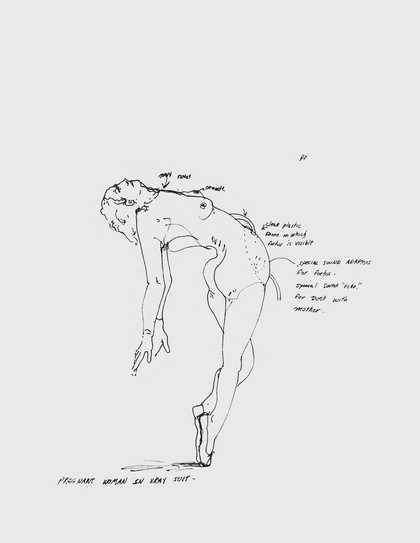
Lynn Hershman Leeson, Pregnant Woman in XRay Suit c.1965, ink on paper, 38.1 × 33.7 cm
© Lynn Hershman Leeson, courtesy the artist and Anglim Gilbert Gallery, San Francisco
The artist suffered from a collapsed heart valve in 1966 after complications during pregnancy, spending more than a month in an oxygen tent. Suffused with extraordinary vapours, her body needing the supplement to draw enough air into her lungs, Hershman Leeson seemed to register this transfusion in a series of kinetic sound sculptures called Breathing Machines. These wax impressions of the artist’s face concealed motion sensors that, when a viewer passed by, triggered a tape playback of the sound of Hershman Leeson’s breathing – a literal manifestation of her own traumatic experience. Yet, in fact, the artist had already begun these works in 1965, and so a central contradiction, or fascination, of her work becomes clear: despite similarities or affinities, there is no simple correlation between her biography and her work. The relation between her self and her art is continually divided and splintered; the one does not immediately follow from or reflect the other. Instead, the two are cleaved by delay, anachronism and difference. In this way, the Breathing Machines are not so much mimetic as they are enactments of the split between self and playback, soul and effigy, vita and dead air.
Indeed, in some of the Breathing Machines the sound recordings included speech that addressed the viewer directly – but always with shifters, pronouns that could be inhabited and received by anyone, such as you, he, she. The schizophrenic simultaneity of automation and subjectivity held together in one breath. A Second Life.
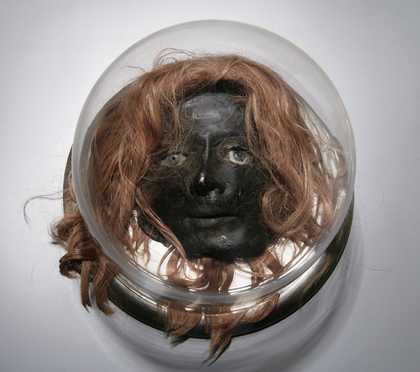
Lynn Hershman Leeson, Breathing Machine 1967, wax, wig, glass eye, makeup, Plexiglas, wood, sensors, sound, 32 × 42 × 42 cm
The Museum of Modern Art, New York, © Lynn Hershman Leeson, courtesy the artist
Hershman Leeson also used breathing recordings in The Dante Hotel, an astonishing project that crystallised the notion of the impending universe of surveillance – the I always watched by a they, the body constantly invaded by the machine. On view for almost one year from late 1973 to August 1974, the project presented an ersatz crime scene. The artist placed ads in the newspaper that simply cited the artist’s name, room number, location and time frame – ‘PERMANENTLY / Open 24 hrs.’ Anyone could go to the address, walk into a seedy North Beach hotel in San Francisco, sign in at the front desk and go up to the room. There they found figures in a disheveled bed, clothes and books and toiletries strewn about, the radio on, and the sound of bodies inhaling and exhaling. Eventually, one guest – thinking the bodies were corpses – called the police, who seized all the ‘evidence’ and removed the installation, thereby forcing its end. But, true to form, the heads of the figures in the bed were actually wax moulds covered with wigs; the face of one was taken from the artist’s.
The tableau staged a situation of voyeurism and monitoring. As a viewer, you were in a state of always being watched or registered (by the desk attendant, other viewers), but you also experienced the thrill of seeing something that was hidden away, a kind of forensic revelation. The work maps the intrusion of a strange public peering into the private enclave. But it is also a collision of the live and the mediated. Photographs of the scene itself lined the walls of the room, as second-order reproductions of the already reproduced, waxen dummies. And the scene is an automated one: the radio, sounds and the circulating newspaper ads through which people found out about the place are all part of a physically realised system of communications technologies. The identities of the non-existent occupants were defined by a kind of absence, as Hershman Leeson has described it – a network.
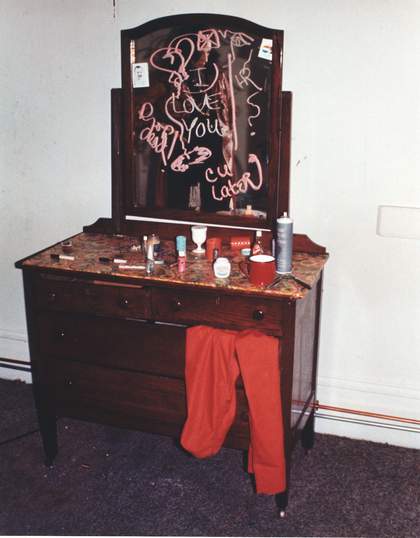
Detail of the site-specific installation The Dante Hotel, made using wax figures and audiotapes in a room of the Dante Hotel in San Francisco, 1973–4
© Lynn Hershman Leeson, courtesy the artist, Bridget Donahue, NYC and Anglim Gilbert Gallery, San Francisco
The ‘spirit’ of the guests in Room 47 was to live on, in a manner of speaking, in Hershman Leeson’s next project, Roberta Breitmore – an ‘alternative personality’. For nearly a decade, beginning in 1973, the artist constructed an extraordinary simulated persona, complete with a bank account, wardrobe, driver’s licence and a life of her own. Dressed in costume, wig and glasses, Hershman Leeson would go out and meet people, encounters that were sometimes orchestrated by classifieds she took out seeking a roommate, or through personal ads; she saw a therapist, interviewed for jobs, hired multiple other people to ‘play’ her, and hired a surveillance photographer to tail her. A delicate, ghoulish series of diagrammed photographs of her face and torso – ‘Construction Charts’ – show how to make Roberta up with Max Factor blue eye shadow, ‘Date Mate’ scarlet lipstick, and a ‘$7.98 three-piece dress’. Roberta exists not in flesh but in image, consumption, reproduction, transmission, communications, paperwork, data. She renders the human subject – its fears, its compulsions, its frailties, its joy – as wholly generated by bureaucratic registration, institutional apparatuses and technological media.
Hershman Leeson has continued to probe the ways in which the subject is never stable or self-identical but always discontinuous, striated – defined by new media and reproductive technologies, by rules and codes and systems. And so, while her early projects are contemporaneous with postwar neo-avant-gardes, her work counters any understanding of this movement as one preoccupied by performative and embodied immediacy. Unlike most Fluxus events, happenings, or performance pieces of the time, Hershman Leeson’s work contemplated the reification not only of immediate everyday experience but of all forms of mediation: the networked effects of cameras, newspapers, projected images, mirrors, tape recordings, kinesis, radio networks, surveillance. So, too, she has addressed the reification of knowledge: instruction, research, invention and scientific innovation.
In the 1990s, she took the creation of personae to the Internet – where we see what she calls the ‘Birth of the Anti- Body’, a kind of being whose ‘DNA’ is constituted by surveillance, capture and tracking, attaching itself like an antivirus to different nodes in the network. This new cyborg subject ‘has chosen to negate the selfhood into which she was born’. One such virtual avatar is the focus of the ongoing, interactive multi-user piece Agent Ruby, begun in 1998. The protagonist is an artificially intelligent entity with whom one can chat at via the website www.agentruby.net (she also appears as a character in Hershman Leeson’s film Teknolust 2002). Ruby logs all questions and interactions; searches the internet to continually expand and upgrade her archive of information; and continually changes with each new interaction, growing smarter, adapting. Hershman Leeson soon launched an animation named DiNA 2004, a 2.0 version of Ruby that uses voice-recognition technology to interact with users. A female projection, DiNA responded in real time with speech, facial expressions and a quick learning curve.
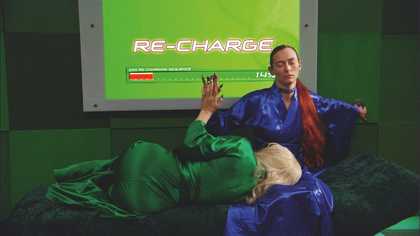
Tilda Swinton as cyborgs Olive and Marine (and Ruby, not pictured) in Lynn Hershman Leeson's film Teknolust 2002
© Lynn Hershman Leeson, courtesy the artist
Artificial intelligence and genetic engineering run amok in The Infinity Engine 2014, a sprawling, multipart, interactive installation resembling an otherworldly biotech lab. The piece functions as a database of new forms of life: a fluorescent cat crossed with jellyfish genes; a pesticide-resistant plum; a glowing zebrafish. A stunning array of images of these genetically modified animals and crops line the walls, and examples of bioprinting (noses, ears) punctuate the space. The most ambitious component is a scanning booth that uses unprecedented technology to capture the images of visitors, and then analyse the resulting facial recognition data via DNA genome archetypes, in order to discern genetic markers such as gender and origin. Hershman Leeson worked with the biologist and biohacker Josiah P Zayner to develop the DNA facial recognition technology, auguring a future in which DNA testing and gene mutation are not predicated on physical extraction or privatisation, but available to all. (Geneticist George Church, whose interview with Hershman Leeson forms part of the installation, has been at the forefront of this movement for open access genome sequencing.) The artist has recently just converted the film component of The Infinity Engine into a DNA sequence – a completely novel form of archiving that will, according to scientists, last for a million years.
Such an endeavour takes biometrics into the age of big data. If there is a defining aspect to The Infinity Engine, it is infinity itself – the seemingly unlimited proliferation of information, the colossal scale of data before us. It is this vast expansion that, in fact, is mobilising the next frontier of artificial intelligence. Because now the data set, not the algorithm, is the most important and valuable technology. For example, because we upload so many photographs of people to Facebook, and because we tag those photos – billions and billions of them – with salient information, we train the network. We instruct it as to what these images are (and, by default, what they are not); we give it the ability to learn. And so Facebook has been able to train its neural networks to be more and more accurate at solving problems, such as recognising an individual’s face, because of the exponentially gargantuan quantities and the increasingly diversified qualities of the information it has amassed. By the same token, many machine learning algorithmic frameworks are freely available or open-source, but it is Google’s megalithic trove of data – culled from its total domination of internet search – that is the basis for making its neural networks smarter. This is how big data is advancing artificial intelligence: an infinity engine.
Hershman Leeson pushes the limits of artificial intelligence, the limits of prosthesis, in order to understand not only the redefinition of the human, but of the organic itself. Nature is no longer natural. And yet she is not content to simply log the ways in which governments and corporations have reprogrammed life. Her work continually poses an alternative path, an alien network, a different ontology. This is the basis for her latest work – developing a literal antibody, dubbed the ‘Lynn Hershman’, with pharmaceutical giant Novartis. As luck would have it (although, perhaps more so than any other artist I know, Hershman Leeson makes her own luck), a Novartis executive sits on the board of the Haus der Elektronischen Kunst in Basel, where the artist has a solo exhibition opening this month. Hershman Leeson knew that Novartis was conducting some of the most advanced research on antibodies, and so she asked HeK’s curator, Sabine Himmelsbach, to connect her with scientists there – and then ‘the magic happened’, as Hershman Leeson puts it.
The artist embarked on a months-long process of ‘therapeutic antibody discovery’ with scientist Thomas Huber at the Novartis Institute for BioMedical Research (NIBR). When a cell has the ability to form antibodies that can recognise an antigen (a process called gene rearrangement), developing key-like ‘grooves’ that can fit into a ‘lock’, the cell gets a positive sign to proliferate. Hershman Leeson and Huber and his team spurred these somatic recombinations using a specific amino acid sequence. The resulting antibodies are then synthesised, cloned, fully assembled by host cells, purified and characterised (via protein gel analysis, in which proteins are separated according to their size and stained with a blue dye). Just this past January, the Lynn Hershman antibodies were successfully harvested from the cell culture and reproduced. By the time you read this, they will know what the antibody can treat.
We, as a species, are undergoing radical genetic change, and the asymptotic explosion of information – biological, computational, material – is transforming the very definition of sentience. This is both a terrifying prospect and a liberating promise. Hershman Leeson chooses to fight for the latter – forging the counter weapons, the antibodies, that we will need to remake ourselves, and the world.
Lynn Hershman Leeson: Anti-Bodies, HeK (House of Electronic Arts Basel), Switzerland, until 5 August. Lynn Hershman Leeson: The Novalis Hotel and First Person Plural, KW Institute for Contemporary Art, Berlin, opens 19 May. The Infinity Engine will be shown at the inaugural Riga International Biennial of Contemporary Art (RIBOCA1), 2 June – 28 October. Several works by Lynn Hershman Leeson are on display at Tate Liverpool.
Michelle Kuo is the Marlene Hess Curator of Painting and Sculpture at the Museum of Modern Art, New York and was editor-in-chief of Artforum from 2010 to 2017.

